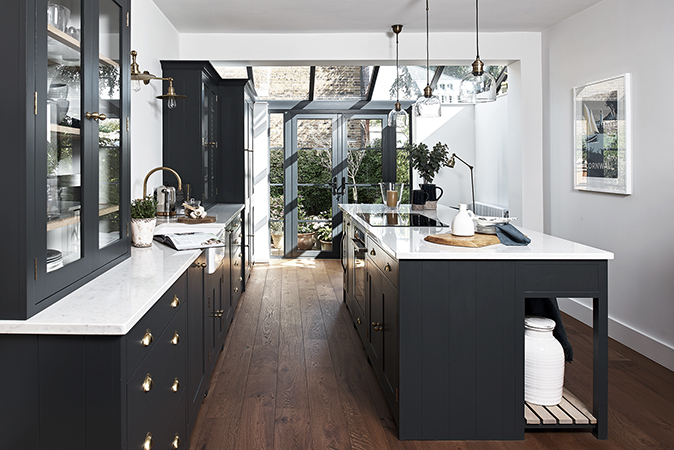The design of kitchen islands is evolving fast to accommodate everything from wine fridges and seating to appliances, says Amelia Thorpe.
Given the importance of kitchens, it’s hard to believe that they were once banished ‘below stairs’. Today’s kitchen is where many of us choose to spend most of our time; it’s where we live, dine and socialise when we are at home. Along with its increased importance comes growing scale, hence the arrival of the island, the central feature of many beautiful kitchens.
Over the past couple of decades, the kitchen island has evolved from a simple work station to include a host of features. It serves as the ‘beating heart’ of the room, where meals are prepared, bags of shopping are unloaded, children perch for breakfast, wine is poured and friends gather.
No longer banished to some distant galley, the cook can prepare the dinner while facing friends and family and join in the conversation. With one side devoted to cooking, another to bar stools, the island defines the working zone, so that the cook has room to manoeuvre in a space that subtly discourages friends from getting in the way.
Unlike a table, an island offers lots of storage, as well as room for sinks, bins and built-in appliances, as well as upholstered seating and wine fridges. Electrical sockets for mixers, charging points in drawers for phones and tablets, downdraft extractors that pop up from the countertop and a huge variety of bar stools are all clues that manufacturers recognise the importance of the island in kitchen design, too. Beyond the fact that it needs to fit well in your space, there are no rules to an island’s size, shape or features.
Island inspiration

This island by Christopher Peacock is designed as the family meeting point. Its role is highlighted by a worktop and cabinetry that is distinct from the cupboards and appliances built around the walls.
020–7100 4423; www.peacockhome.com

An Aga sits centre stage as part of a multi- purpose island design by Mark Wilkinson Furniture. Wood provides a warmer-to-touch surface than stone, making it a good choice for a breakfast bar or dining zone. The design includes a simple upstand, which prevents splashes from the sink and cooker reaching those sitting at the bar.
01380 850007; www.mwf.com

In a departure from classic rectangular or square designs, this island by Humphrey Munson features a curved leather banquette to create a convivial dining area.
01371 821300; www.humphreymunson.co.uk

Proof that an island can be a central hub comes in the shape of this design by McCarron and Company. The prep zone closest to the range cooker features an integrated dishwasher and built-in waste bins, both near to the sink, with a breakfast table and bench seating on the far side.
01380 859299; www.mccarronandco.com

A built-in oven and slimline wine fridge, flush-fit hob, plus storage, prep surface and pot board for displays, make this Suffolk island by Neptune a hard-working focal point.
01793 427427; www.neptune.com

This island by Smallbone of Devizes features built-in hobs and masses of storage. Its striking colour and linear design are accentuated by brass channels designed to enhance its role as the focal point of the room. The effect is boosted by the choice of contemporary brass pendant lights
020–7589 5998; www.smallbone.co.uk

More akin to a traditional kitchen table, this design by Plain English cleverly combines classic freestanding looks with practical features. Supported by table legs, it has a ‘lighter’ look than some monolithic island designs.
020–7486 2674; www.plainenglishdesign.co.uk

An island can be used to separate the working area from the socialising space in a kitchen, serving as a bridge between the two. In this design by Tom Howley, the cooking zone is distinct from the ‘on show’ side of the large island, which is used to store table linen and serving platters.
0161– 848 1200; www.tomhowley.co.uk

Officine Gullo combines its Italian-made appliances, sinks and storage to produce an island design to suit any space. This design creates a work and serving station to form a practical transition between indoor and outdoor spaces.
020–7036 1632; www.officinegullo.com

The kitchen dresser, and why it’s ‘more important than central heating’
What is a country kitchen without a dresser overflowing with crockery, car keys and keepsakes? Flora Watkins explains all.

A kitchen that’s a breath of fresh air in a world of homogeneity
Giles Kime takes a look at a new kitchen design that's taken the best elements of Victorian and Edwardian traditions

The new kitchen design mantra: Don’t be afraid of the dark
Dark colours and rich materials are creating moody new looks in kitchens, says Amelia Thorpe.



